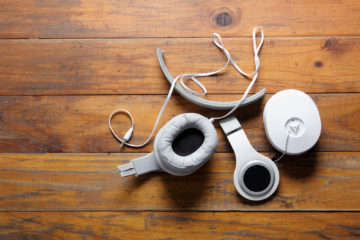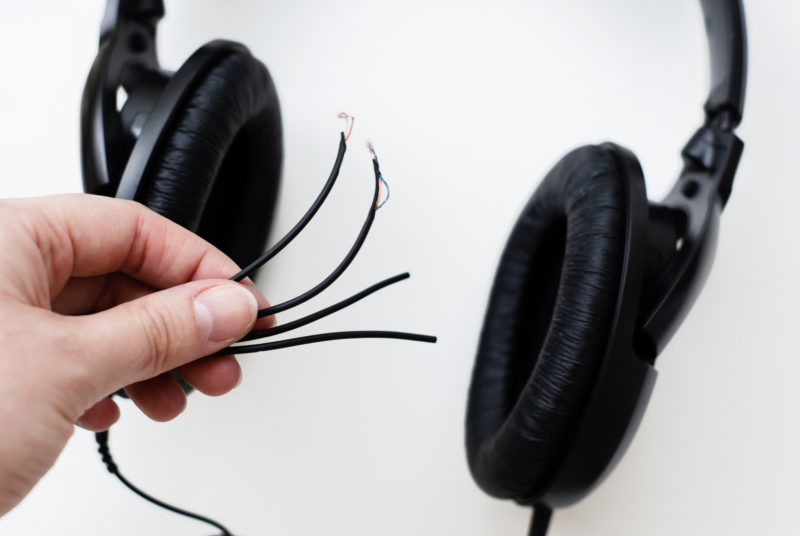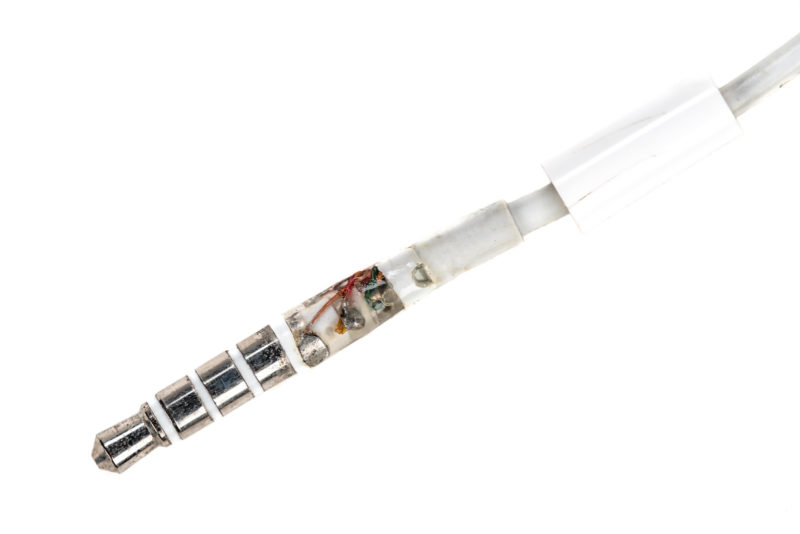How to Charge AirPods Without a Case
Discover the truth about how to charge AirPods without a case. Uncover myths, find alternatives, and safeguard your audio experience.

If you’re someone like me, being careful with your possessions is more aspirational than practical. We drop things, we misplace things, we bang them into walls. Sadly, this is true of some of our most pleasurable and useful devices, like headphones.
If you find yourself with a broken pair of headphones and don’t know what to do with them, this guide will give you some tips on assessing the damage, potentially fixing it, and/or moving on from the headphones in an environmentally friendly way.
If you also want to know how to tell if headphones are blown, we have an article for that.
There are a number of things you can do with broken headphones, like recycling them, donating them, trading them in, or converting them into a speaker or microphone.
Making sure your headphones are actually broken and then taking the steps to dispose of them ethically are important parts of the life cycle of any audio device that you’re getting rid of.
Having a basic understanding of the different components of your headphones can help you figure out how to fix them, but can also give you some direction as to how to recycle them or dispose of them properly.
Headphones are essentially small speakers located within the circuitry of the earcups. These speakers, or drivers, communicate sound to our ears through a complex process that allows us to hear and understand the audio that is being communicated.
Headphones have the following components:
This hard synthetic plastic component offers durability and flexibility for adjusting to different head sizes. However, this type of plastic is not usually recyclable. Try selling or donating it to organizations that can reuse the material.
The ear cups are typically made of hard plastic and/or silicone coated in leather or foam. These materials are unable to be recycled. Try contacting the manufacturer to see if they will take back your damaged product to be reused.
As I mentioned earlier, every pair of headphones have little speakers inside each ear cup that generate sound for your ears to hear. These drivers are made of magnets, diaphragms and coils made of copper. These materials can be recycled (if they are not damaged by too much bass) and you can even try converting your damaged headphones into speakers by removing the drivers from the earcups.

Broken headphones closeup – broken wires sticking out.
Headphone cables are composed of aluminum and/or copper wiring that is encased in rubber or cloth. These materials are recyclable and can be taken to a waste drop off site.

Broken headphone jack
The jack connects your headphones to your device and is made of copper and metal. As I mentioned earlier, these materials are recyclable. However, if the jack is encased in PVC whether it is a 3.5mm or a 1/4″ jack, it is not recyclable.
While headphones do contain materials that are not recyclable, the materials that are recyclable can be dropped off at local recycling centers by using resources like Earth 911, which allows you to search for your nearest recycling center by zip code.
You can also try donating your headphones to companies that manufacture headphones but also have environmentally friendly recycling programs. A great resource to recycle headphones is JLab’s Recycling Program, which accepts headphones of any brand and finds out where and how to dispose of them properly.
Try trading in your headphones to manufacturers that accept them. You can search by the product type and select the quality that the headphones are in. If they are in poor quality but still have some functionality, you may be eligible to receive some money back for their trade-in value.
If you simply intend to recycle them, they will not have any trade-in value as far as dollars are concerned, but you don’t have to worry about holding on to them forever or improperly disposing of them.
Before deciding what should be done with a broken pair of headphones, it’s important to know with certainty whether they are actually broken. It would definitely be a bummer to toss your headphones in a donation box or recycling center when they were still salvageable.
Try isolating what the cause of the dysfunction is in order to determine the right fix.
If you are curious about how long should headphones last, we have discussed that in this article.
The most common issue you will face with wired headphones is audio cut out and damage to the internal wiring within the cable. This damage can occur from extended wear and tear, poor build quality, or improper coiling of the cable when you’re using or putting your headphones away.
In order to replace a bad cable you’re going to need the following tools: wire clippers, wire stripper, soldering iron, solder remover, a screwdriver and a replacement cable.
If your headphones are damaged, but the speakers are still in working condition, you can try turning your headphones into stereo speakers before recycling/donating the remaining parts.
Make sure you have your broken headphones, Bluetooth speakers, and a soldering iron.
Another way to stay environmentally conscious of the waste you are producing by disposing of your headphones is to break down the headphones and hold onto the still-functioning parts.
As I listed earlier, headphones are composed of several different parts that serve different functions.
If you have a relatively new pair of headphones but have broken one of the components, whip out an old broken pair and see if you can replace anything.
Salvaging replacement parts is a great way to save money if you break a part of your headphones and are not interested in replacing the pair altogether. In other words, just because one component of the headphones is broken, does not mean you need to jump ship altogether.
If your headphones are busted but the headband remains intact, make sure to hang onto it because you never know the next time you might snap a headband on a different pair.
While quality brands usually construct durable headbands, the fact remains that they are one of the easier components to break on a pair of over-ear or on ear-headphones. Avoidant future frustration by hanging on to the headband from an otherwise broken pair of headphones.
Due to the frequent contact that earcups have with your body when wearing headphones, they tend to degrade over time. This is especially true if you are wearing headphones for things like mixing/producing audio or for working out.
The leather or foam material the covers the earcups can split or tear, leaving your headphones coarse and unwearable. Try hanging onto the earpads from a broken pair to use as backup for your current pair in case the earcups start to fall apart.
Jacks break all the time and can be a frustrating reason to have to toss an otherwise great pair of headphones. Make sure to hang on to the functioning jack on an otherwise broken pair of headphones because you never know when it’ll come in handy.
As I mentioned earlier, if your headphones are broken chances are it has something to do with the cable. Headphone cables are most vulnerable to normal wear and tear due to their length and potential to be mishandled.
If you’re lucky, some brands will actually include spare replacement cables in case your existing one gets busted. Either way, if your headphones are busted but the cable is fine, you should 100% hang onto it because there is a strong chance you will need a backup over the course of your listening experience.
We are all human. We break things. But just because we break things does not mean we have to waste things. But if you are someone who constantly breaks his or her headphones, you might want to read this article.
By recycling, donating or otherwise repurposing our broken headphones, we can actually help stem the tide of electronic waste, learn some DIY tricks and even save some money in the process!
We can all relate to the feeling of something not working right and then we assume it’s broken and we just try to move on as quickly as possible. But it’s important to make sure your headphones are actually broken before abandoning them.
Take the time to familiarize yourself with your listening companion and keep an eye out for ways to keep it working right.